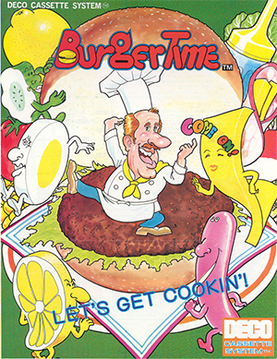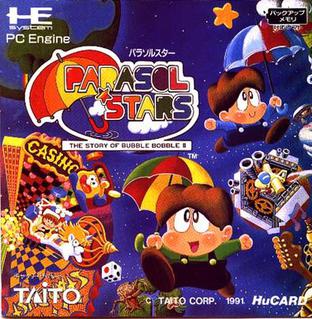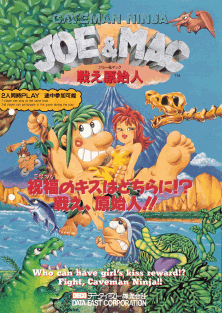
BurgerTime, originally released as Hamburger in Japan, is an arcade video game from Data East. It was published in 1982 for the DECO Cassette System. The player controls chef Peter Pepper who walks across oversized ingredients in a maze of platforms and ladders, causing them to fall and stack on buns below, eventually creating complete burgers. The chef is pursued by anthropomorphic hot dogs, fried eggs, and pickles. A limited supply of pepper can be thrown at aggressors immediately in front of Peter, briefly stunning them.

Wonder Boy in Monster Land, known by its original arcade release as Wonder Boy: Monster Land, is a platform video game developed by Westone Bit Entertainment and released by Sega in Japanese arcades in 1987 and for the Master System in 1988, with a number of other home computer and console ports following. The game is the sequel to the 1986 game Wonder Boy and takes place eleven years after the events in the previous game. After enjoying over a decade of peace on Wonder Land following the defeat of the evil King by Tom-Tom, later bestowed the title "Wonder Boy", a fire-breathing dragon called the MEKA dragon appeared; he and his minions conquered Wonder Land, turning it into "Monster Land". The people, helpless due to their lack of fighting skill, call for Wonder Boy, now a teenager, to destroy the monsters and defeat the MEKA dragon. Players control Wonder Boy through twelve linear levels as he makes his way through Monster Land to find and defeat the MEKA dragon. Players earn gold by defeating enemies and buy weapons, armor, footwear, magic, and other items to help along the way.

Parasol Stars: The Story of Bubble Bobble III (パラソルスター) called Parasol Stars: Rainbow Island II on the NES is a video game by Taito released in 1991. It is a sequel to Rainbow Islands and the third game in the Bubble Bobble series. On July 11, 2024, the game got ported for the PlayStation 4, PlayStation 5, Xbox one, Xbox series X/S, Nintendo Switch, and PC.

Gauntlet II is a 1986 arcade game produced by Atari Games that serves as the immediate sequel to the original Gauntlet, which was released the previous year. Like its predecessor, Gauntlet II is a fantasy-themed top down dungeon crawler game and was released as a dedicated cabinet, as well as a conversion kit, both available in 2-player and 4-player versions.

Bad Dudes Vs. DragonNinja, also known simply as either Bad Dudes or DragonNinja, is a side-scrolling cooperative beat 'em up developed and released by Data East as an arcade video game in 1988. It was ported to computer and game console home systems.

Snow Bros. is a 1990 platform arcade video game originally developed by Toaplan first published in Japan, then in North America by Romstar and later in Europe. Starring the eponymous snowmen twins Nick and Tom, players are tasked with travelling through 50 stages, throwing and building snowballs, jumping on and off platforms to navigate level obstacles while dodging and defeating monsters in order to rescue the princesses Puripuri and Puchipuchi from captivity. Although first launched in arcades, the game was later ported across multiple platforms, each one being created by different third-party developers and featuring several changes or additions compared with the original version. Conversions for various microcomputers were in development but none were officially released to the public.

Ghosts 'n Goblins, known as Makaimura in Japan, is a platform video game developed by Capcom and released for arcades in 1985. It is the first game in the Ghosts 'n Goblins franchise, and it has been ported to numerous home platforms.

Cyberball is a video game released in arcades in 1988 by Atari Games. The game is a 7-man American football using robotic avatars of different speeds, sizes, and skill sets set in the year 2022. Originally released for arcades, Cyberball was ported to several home consoles and computers.

Solomon's Key is a puzzle game developed by Tecmo in 1986 for an arcade release on custom hardware based on the Z80 chipset. It was ported to multiple systems including the Nintendo Entertainment System and Commodore 64. The PC Engine version was known as Zipang and the Game Boy version as Solomon's Club. A prequel, Solomon's Key 2, was released in 1992 for the NES. The NES version of the game was also released in emulated form on Virtual Console for the Wii in 2006, Nintendo 3DS and Wii U in 2013 and later to Nintendo Switch Online in 2018.

Putty is a game developed by System 3 and released in 1992 for the Amiga. It was also released on the Super Nintendo Entertainment System in 1993 as Super Putty and Amiga CD32 version was published in 1994 under the same name.

City Connection is a 1985 platform game developed and published as an arcade video game by Jaleco. It was released in North America by Kitkorp as Cruisin'. The player controls Clarice in her Honda City hatchback and must drive over elevated roads to paint them. Clarice is pursued by police cars, which she can stun by hitting them with oil cans. The design was inspired by maze chase games like Pac-Man (1980) and Make Trax (1981).

Rygar is a 1986 side-scrolling platform game created by Tecmo. Originally released for Japanese arcades in June 1986, the game was subsequently ported to the NES (1987), Commodore 64 (1987), ZX Spectrum (1987), Amstrad CPC (1987), Master System (1988), Atari Lynx (1990), and X68000 (1994). Emulations have also been released for Xbox (2005), Sprint mobile phones (2005), Wii (2009), PlayStation 4 (2014), Nintendo Switch (2018), and Android (2023), with an unofficial fan-made emulation released for Amiga AGA in 2019. A remake, Rygar: The Legendary Adventure, was released for PlayStation 2 in 2002. The Legendary Adventure was remastered for the Wii in 2008 as Rygar: The Battle of Argus.

Double Dragon is a 1987 beat 'em up video game developed by Technōs Japan and distributed by Taito for arcades across Asia, North America and Europe. It is the first title in the Double Dragon franchise. The game's development was led by Yoshihisa Kishimoto, and it is a spiritual and technological successor to Technos' earlier beat 'em up, Nekketsu Kōha Kunio-kun (1986), released outside of Japan by Taito as Renegade; Kishimoto originally envisioned it as a direct sequel and part of the Kunio-kun series, before making it a new game with a different cast and setting.

Joe & Mac, also known as Caveman Ninja and Caveman Ninja: Joe & Mac, is a run and gun platform game released as an arcade video game by Data East in 1991. It was adapted for the Super NES, Mega Drive/Genesis, Nintendo Entertainment System, Game Boy, Amiga, Zeebo, Nintendo Switch, and IBM PC compatibles.

The Addams Family is a platform game based on the 1991 film of the same name and developed and published by Ocean Software. It was released for home consoles such as the Super Nintendo Entertainment System, computers such as the Amiga, and handheld consoles like the Game Boy.

Ninja JaJaMaru-kun is an action-platform video game developed and published by Jaleco for the Famicom. It was released in Japan on November 15, 1985, and was ported to the MSX in 1986. The MSX version was released in Europe as Ninja II, being marketed as a sequel to Ninja-kun: Majou no Bouken, a game that used the name Ninja for its European MSX release.

First Samurai, alternatively titled The First Samurai, is a 1991 beat 'em up platform game developed by Vivid Image and published by Image Works. The First Samurai was originally released in September 1991 for the Amiga and Atari ST, and was later ported to the Commodore 64, MS-DOS and the Super Nintendo Entertainment System. It was followed by a sequel, Second Samurai, in 1994. In 2011, a port was released for iOS.

Magic Boy is a platform game developed by Blue Turtle and published for the Amiga, Atari ST, and MS-DOS by Empire Interactive in 1993. A Super Nintendo Entertainment System version was published in 1996 in North America and Europe by JVC Musical Industries.
Quattro is a series of video game compilations released in the 1990s. They consisted of games developed by Codemasters. The NES versions were released as multicarts and were published by Camerica without a license by Nintendo.

P-47: The Phantom Fighter is a 1988 horizontally scrolling shooter arcade video game originally developed by NMK and published by Jaleco. Set during World War II, players control a Republic P-47 Thunderbolt fighter aircraft to face against the Nazis, who are occupying multiple countries around the world. Its gameplay involves destroying waves of enemies, picking up power-ups and new weapons, and destroying bosses. It ran on the Mega System 1 hardware.




















